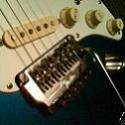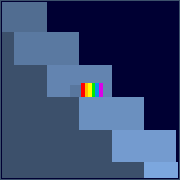|
I think volcas are the cheapest but they dont have real keyboards
|
|
|
|

|
| # ? May 24, 2024 17:17 |
|
Reface CS would be super cool and you can usually use promo codes at guitar center etc on Yamaha products to get them even lower. e: Arturia MicroFreak would be a real fun option too
|
|
|
|
Yeah the microfreak checks a lot of boxes there, plus the vocoder is added fun
|
|
|
|
|
Iíve been trying to deep dive into wavetable synth theory for the past few days but despite each tutorial being explicitly clear on what is going on, I still canít wrap my brain around how this isnít just subtractive and what makes it special. This is like when I tried to learn related rates calculus in school and my brain literally broke and stopped between one step and the next. I go from ďI understand exactly what is happeningĒ to ďI have no idea what just happened, I am very lost and scaredĒ
|
|
|
|
I am not sure that it is going to differ from subtractive or additive synthesis after a certain point, since you're going to either be combining waveforms from wavetables for reasons, or subtracting from them with filters, or both. Mainly it's just the oscillator source itself comes from the wavetable, right? With the capabilities to move through the wavetable in different ways as part of the sound source. Then you do other synth stuff that would also make sense with other oscillator sources from that point.
Agreed fucked around with this message at 21:34 on Jul 23, 2021 |
|
|
Martytoof posted:Iíve been trying to deep dive into wavetable synth theory for the past few days but despite each tutorial being explicitly clear on what is going on, I still canít wrap my brain around how this isnít just subtractive and what makes it special. itís literally just subtractive synthesis with a more complex oscillator. with stuff like serum you can use the wavetable as a sampler or granulator so itís very powerful but itís not like this hugely different thing from a ďnormalĒ subtractive synth
|
|
|
|
|
petit choux posted:Hey all, here's a simple question: if I want to introduce a young person, say 14 years old, to electronic music and synths, what would be some good options? I'm thinking of a all-in-one type thing to introduce them without getting too costly or too technical to start with. Something with a keyboard. Do they have a computer? A MiniLab is only a hundred bucks, and it comes with some good software. If they want to dive deeper, they can upgrade Analog Lab for $69 (nice) and/or get Pigments for $99.
|
|
|
|
Ah ok so Iím not crazy then. Thereís no weird magic happening, itís just other soundforms providing more complex oscilators.
|
|
|
Google Butt posted:Yeah the microfreak checks a lot of boxes there, plus the vocoder is added fun Yeah, I'd like to have one myself. I think having a few real gee wizz things can be really helpful for getting somebody young into it. Something that makes them go wow. Like I had a Yamaha DJX keyboard a few months ago, I don't know why they don't make more stuff like that now. It's got some sampling, lots of good synth voices, some great effects, lots of stuff to get somebody excited about it, a DJ approach to layering sounds, lots of modern beats, but it's also got some basic piano stuff as well so you could do traditional piano lessons. But that's from 20 years ago.
|
|
|
|
|
Martytoof posted:Ah ok so I’m not crazy then. There’s no weird magic happening, it’s just other soundforms providing more complex oscilators. From what I understand wavetables are soundsources which are somehow 3 dimensional (a collection of different waveforms you scan through) when "standard" waveforms are 2 dimensional (amplitude over time). That's it. It's unrelated to filters or wavefolding. You can have a wavetable of filtered waveforms, or a wavetable of folded waveforms, or boths, or any waveforms you can imagine. In a way, a very basic wavetable would simply be to modulate a parameter from a standard waveform over time, like folding or filtering.
|
|
|
brand engager posted:I think volcas are the cheapest but they dont have real keyboards Yeah, Volcas and Pocket Operators are a good introduction, too. I'm just trying to see if there's something out there with a conventional keyboard as well. I'm a big fan of the POs myself. The only thing that bugs me about them is the fact that they aren't actually marketing to teenagers, contrary to their name. I wish I were seeing kids playing them on the metro and stuff.
|
|
|
|
|
petit choux posted:Hey all, here's a simple question: if I want to introduce a young person, say 14 years old, to electronic music and synths, what would be some good options? I'm thinking of a all-in-one type thing to introduce them without getting too costly or too technical to start with. Something with a keyboard. Get them a cheez Casio - some of them come with Midi/usb outs, like the Casiotone (can be battery powered), that you can also plug into something like a cheapie MeeBlip Geode or a softsynth.
|
|
|
|
petit choux posted:Hey all, here's a simple question: if I want to introduce a young person, say 14 years old, to electronic music and synths, what would be some good options? I'm thinking of a all-in-one type thing to introduce them without getting too costly or too technical to start with. Something with a keyboard. I regret selling my (red) Microbrute at least once a month. Basic knobby monosynth with a sequencer and a bit of patchability for cheap.
|
|
|
|
I thought wavetable synthesis was just one cycle of a waveform. I know with old school 8bit computers, a single waveform would keep the memory down. I've played with single period waves on Milkytracker, it's fine whatever. Minimalism is cool. I'm thinking of taking the Octatrack and outputting the Left and Right to the inputs of the Portastudio. Then Outputting all four channels right back into the Octatrack. Like looping them both together. Then I could bounce them off of each other, for god knows what. Some kind of unknown territory.
|
|
|
|
petit choux posted:Hey all, here's a simple question: if I want to introduce a young person, say 14 years old, to electronic music and synths, what would be some good options? I'm thinking of a all-in-one type thing to introduce them without getting too costly or too technical to start with. Something with a keyboard. https://www.youtube.com/watch?v=w077zoZb1tw These are $200. Fine groove box, synth, all-in-one good time. I have the 8bit warps (chip tune version). Powerful and simple at the same time.
|
|
|
|
An ableton license probably? Like being real here. When I was 14 I was way more excited about Fruity Loops than whatever Novation was doing that year
|
|
|
|
$10k worth of eurorack modules, kids love plugging stuff in and turning knobs, right??
|
|
|
|
Or a music easel maybe? e: it's a shame this isn't a realistic recommendation because it really, truly, feels like the correct one to me
|
|
|
|
watho posted:itís literally just subtractive synthesis with a more complex oscillator. with stuff like serum you can use the wavetable as a sampler or granulator so itís very powerful but itís not like this hugely different thing from a ďnormalĒ subtractive synth no, it's really not. unless you're willing to make the claim that anything fed through a filter is subtractive synthesis with a more complex oscillator. let's say you sampled a filter sweep, then split your sample into tiny chunks, then you laid each chunk down in a grid, then you interpolated between any two cells in the grid, then you repeated the last step a bunch of times, that's wavetable synthesis. if you interpolate through the cells in the example from start to finish, the end result will be a filter sweep. but at no point in time would you need to send the output of the wavetable oscillator through a filter in order to get the sound of a filter sweep. the oscillator does all the heavy lifting, you get the timbres you want by picking what goes into your wavetable. the coolness and distinctness of the technique is that all the sample chunks making up your table can be anything and you can cycle through them however you like. so, for example, let's say that you take 20 sample chunks from your previous example and 20 sample chunks of a fart being expelled through a trumpet and 20 sample chunks of a power drill and use that as your wavetable. set up a few modulators to determine the next cell in the wavetable to be interpolated to and you have industrial hellnoise that you absolutely can't get with a vco/vcf. not because of complexity or power or anything quantitative, but because it's a fundamentally different means of producing sound. if you have serum, pick a vowel or consonant wavetable, set the volume envelope with 100 sustain and no attack or decay, leave the filters and effects in bypass and map a slow sine lfo to wavetable position (or whatever it's called in serum), it should sound vaguely like someone opening and closing their mouths to make a aaaaaaaaaeeeeeeeoooooooooeeeeeeeeeeaaaaaaa kind of sound. now change the lfo to random or s/h and it should sound like a broken speech synthesizer. that's the best, simple hugely different from subtractive synthesis example I can think of
|
|
|
|
xzzy posted:$10k worth of eurorack modules, kids love plugging stuff in and turning knobs, right?? the korg synth module lil bits were almost there. if the magnetic link up weren't so flaky, the knobs and switches bigger and the price the same, I could totally see a teen taking their table bussing wages or their allowance down to target, picking up a $20 synth module and spending the rest on weed
|
|
|
|
JamesKPolk posted:An ableton license probably? Like being real here. Or FLStudio? But either way you'd definitely want a MIDI keyboard too. If you're getting Pocket Operators, get some kind of cheap mixer for them. While in theory the POs can be chained, the input signal goes through the FX on the next PO in the chain rather than being passed through clean, so it rapidly starts sounding bad if you're using them that way.
|
|
|
|
The Voice of Labor posted:no, it's really not. unless you're willing to make the claim that anything fed through a filter is subtractive synthesis with a more complex oscillator. I guess the thing with modern "wavetable synths" (Serum, Pigments, etc) is that they let you do either or both. You can pick a wavetable that's just classical oscillator waveforms, freeze it in place, and do subtractive synthesis. You can also do all of the stuff you described above by moving through wavetables without doing anything resembling subtractive synthesis. And you can do both at once, with a bunch of envelopes and LFOs mapped onto any part of it.
|
|
|
|
The Voice of Labor posted:no, it's really not. unless you're willing to make the claim that anything fed through a filter is subtractive synthesis with a more complex oscillator. Not every wavetable oscillator interpolates - though I agree the ones that do are more fun!
|
|
|
|
Is a DCO oscillator an analog-implemented wavetable? Following from this, is Roland's famous 80s stage workhouse the JX-8P a wavetable synth or a subtractive synth? Why or why not?
|
|
|
|
more like divisive synths gottem
|
|
|
|
JamesKPolk posted:Is a DCO oscillator an analog-implemented wavetable? Following from this, is Roland's famous 80s stage workhouse the JX-8P a wavetable synth or a subtractive synth? Why or why not? iirc a dco is more like an analog oscillator slaved to a digital clock source. your grey devo sounding membrane button beauty with busted aftertouch fails on the points of having waveforms of arbitrary timbrel quality and being able to cycle between different ones
|
|
|
Lead out in cuffs posted:Or FLStudio? But either way you'd definitely want a MIDI keyboard too. Incidentally, this is exactly what I've done. Also, you can use a digital metronome as the sync master so you can put all the POs in sync 2 or whatever so none of them has to be master. It just has to have an earphone jack, like my teeny Korg does. So the sync track comes from the metronome, is split one for every PO, then all the music will go out to the Hart Maker Just Mix. They all start and stop when the metronome does, and sync to its tempo identically. Easy peasy.
|
|
|
|
|
I think my first experience to the concept of making music with a computer was a copy of FruityLoops 2 on Win95 or something back in the super late 90s. Iím not sure I even gave a thought to where electronic music came from before then, but all of a sudden I was smacked in the face with the concept that holy poo poo I can use a computer to make these awesome sounds. I mean I donít remember whether FL2 was in a state to churn out anything useful but the next year or two immediately deep dived into DAWs for my brand new teal iMac and realized there was this whole loving world of people doing amazing things. I really regret not following that path once I got a steady job in IT but it was super eye opening.
|
|
|
|
https://www.youtube.com/watch?v=Jyptp6Z4w0k it's a lame thing to take comfort in, but the trees in british columbia are only marginally bigger than the ones in southern oregon and significantly smaller than the ones in northern california. though I'm left wondering, if canadians are as bad a fuckups as americans, who other than vietnam and cuba is left to look up to on the world stage?
|
|
|
|
Lead out in cuffs posted:I guess the thing with modern "wavetable synths" (Serum, Pigments, etc) is that they let you do either or both. You can pick a wavetable that's just classical oscillator waveforms, freeze it in place, and do subtractive synthesis. You can also do all of the stuff you described above by moving through wavetables without doing anything resembling subtractive synthesis. And you can do both at once, with a bunch of envelopes and LFOs mapped onto any part of it. the ppg wave had vcfs as did the waldorf microwave. it could do both too. if you have a wave memory already set up, doing a single cycle of a basic waveform is trivial.
|
|
|
|
The Voice of Labor posted:iirc a dco is more like an analog oscillator slaved to a digital clock source. your grey devo sounding membrane button beauty with busted aftertouch fails on the points of having waveforms of arbitrary timbrel quality and being able to cycle between different ones Okay but thats not just wavetable synthesis, thats real-time (voltage controlled? otherwise it's all steppy and gross) wavetable interopolation w/ user-loaded tables, which is a much narrower featureset (and cool as hell! Still no argument there) Same question but about a Nord Lead
|
|
|
|
can a nord lead sound like a fizmo?
|
|
|
|
yeah sure probably, they both do saws right?
|
|
|
|
I mean a dx7 can do a saw w 2 ops and a slider
|
|
|
|
what is a wave table? what does it mean to be frequency modulated?
|
|
|
|
|
I don't know if this will help explain a wavetable but thought it was worth a try. https://i.imgur.com/ERT64JU.mp4 You can sweep through the table forwards or backwards or pick a position and just play that as your waveform. The "table" can be different wave forms per "row" or a sliced up piece of coherent audio. Stoca Zola fucked around with this message at 10:47 on Jul 24, 2021 |
|
|
|
The Voice of Labor posted:simple hugely different from subtractive synthesis example I can think of the concept of subtractive synthesis is: - start with a harmonically rich waveform like a dwat, or a dwow - remove harmonics where that waveform comes from or how you remove harmonics is out of scope this is defined so that it can be distinguished from additive synthesis, which is: - start with a harmonically poor waveform (sine) - throw a bunch of 'm together or modulate them to create additional harmonics additive synthesis was a thing when you only had lab equipment and you could generate several sines at precise pitches, then record that to tape and cut it up, or when a computer was used to calculate the pitches over time and could spit out some pdp-11 assembly code which could then be tediously converted to the right voltage Martytoof posted:Ah ok so Iím not crazy then. Thereís no weird magic happening, itís just other soundforms providing more complex oscilators. an electronic circuit has no problems generating a stable saw or triangle wave. in fact, you only need a saw wave to begin with to turn it into a square - just amplify it until it clips, basically, and this is why old synths just have saw + square. that whole stability is important because you don't want to have poo poo getting out of tune when you want to make a more complex sound, you need several oscillators. if you put 'm together, they can get out of tune easily, and either way, this eats up quite some resources and makes the circuit harder to stabilize or you need more parts. no problem if you just have a monosynth, but if you want 8 voices, you're paying through the nose for it when the microprocessor revolution for synths got underway, someone came up with the idea to fix two things at once. - you can store very short samples in ram for a reasonable price - a sample of a saw wave looks like this: 0, 1, 2, 3, 4, 5, 6, 7, 8, 9, 0, 1 (and so on, and in binary, but you get the idea) - you can put whatever sample you want in there, it doesn't have to be saws as long as it fits - if you play that sample with a clock that's running at several megahertz and then divide that clock signal to audible range, you can get a very stable signal, because the clock itself can be stabilized really easily. meanwhile, generating a very stable 3.245 volts is much harder, so if it fluctuates so 3.246 your note is suddenly out of tune then you convert those numbers in ram to voltages and smooth them out a bit, you get any waveform you want. if you do atari-racing-the-beam-style changes in ram where you update the waveform after it's finished playing, you can change waveforms while they're being played in the 1980s this was huge - https://en.wikipedia.org/wiki/PPG_Wave nowadays it's huge because it allows for cool waveforms besides the vanilla saw + pulse and if you play those complex waveshapes back at a low pitch you get all these gnarly effects that brostep kids love also, wavetable synths like pigments, vital et al tend to be "supersynths". a jupiter 8 has 2 LFOs, vital has 8 of 'm and they can be pointed to anything and everything watho posted:what is a wave table? what does it mean to be frequency modulated? a wavetable is a film strip of waveforms that all have an equal pitch. you can scrub forwards and backwards between them. if you start with a square and end with a sine, a wavetable oscillator will fill in the blanks and slowly morph from one shape to another. https://www.youtube.com/watch?v=vvBl3YUBUyY lol all of this is completely useless knowledge, buy what you can afford and hit record
|
|
|
NC Wyeth Death Cult posted:Get them a cheez Casio - some of them come with Midi/usb outs, like the Casiotone (can be battery powered), that you can also plug into something like a cheapie MeeBlip Geode or a softsynth. There's a lot of good sense in this. Also, a lot of them have MIDI in, so you can control them with a cheap MIDI controller - results may vary - like a used Oxygen8 you can find for $25 and add a pitch bend because they usually don't have that. It's also the cheapest solution. But I really want to add some of that extra umph to make it exciting for a young one. Still, especially when you look at the used market, you can find some really feature-packed keyboards for real cheap. I'm seeing Casios with USB for under $50, and you can sure get some suitable software for free or cheap, so you can get a basic DAW setup for that and the price of a decent computer. Of course there's a lot of cultural opposition to using computers, but that's another issue. petit choux fucked around with this message at 11:12 on Jul 24, 2021 |
|
|
|
Laserjet 4P posted:picking a more exciting waveform instead of a saw or triangle core does not suddenly not make it different from subtractive And if you do it enough at least some of this will come to you intuitively BTW, absolutely awesome dialogue on this topic.
|
|
|
|
|

|
| # ? May 24, 2024 17:17 |
to be clear i was a making a joke about this old tweet  iím very well aware what both wavetables and fm is
|
|
|
|



































